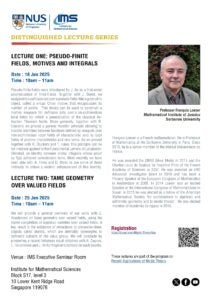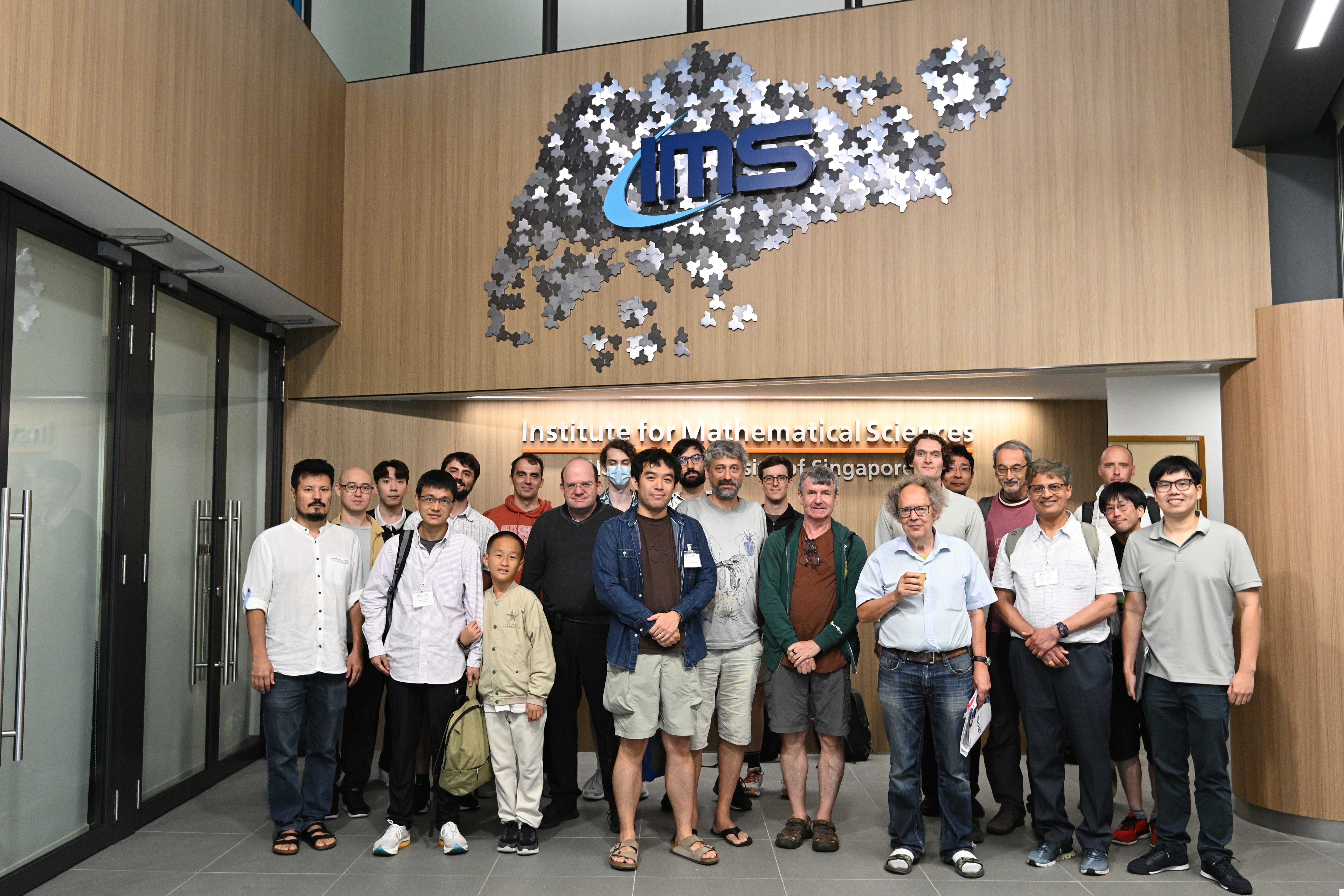Organizing Committee
Co-chairs
- Artem Chernikov (University of California, Los Angeles)
- James Freitag (University of Illinois Chicago)
- Kobi Peterzil (University of Haifa)
- Chieu-Minh Tran (National University of Singapore)
- Jinhe Ye (University of Oxford)
Overview
This conference is centered around applications of model theory where there have recently been mathematical breakthroughs. In particular, we will consider recent interactions of model theory with combinatorics, valued fields, complex geometry, and differential algebra.
Details of the topics are as follows:
- Model theory and combinatorics
Model theory provides methods of converting asymptotic quantitative questions about properties of families of finite (hyper-)graphs or groups into qualitative questions about the “shape”, “volume” or “dimension” of certain limiting infinite objects to which the infinitary model-theoretic machinery can be applied. Shelah’s classification program isolates several combinatorial dividing lines (stability, NIP, distality, n-dependence, etc.) separating mathematical structures exhibiting various degrees of wild, or Goedelian, behavior, from the tame ones. There have been several exciting developments in recent years illustrating the fruitful cross-interaction between model theory and additive and extremal combinatorics.
One important line of work starts with Hrushovski’s advance in understanding approximate subgroups of a group G, that is, finite subsets A which are close to being groups in that the number of elements of G expressible as products of length n of elements from A grows slowly in n (and in the presence of measure on G, subsets with small growth with respect to this measure). His methods use ultraproducts and stability-theoretic techniques to make a link to Hilbert’s 5th Problem. These methods were further developed by Breuillard, Green and Tao to obtain a classification of approximate subgroups as being close to generalised geometric progressions, with a further description of approximate subgroups of linear algebraic groups (obtained also by Pyber and Szabo). This is currently an active line of work, including recent extensions of these results to approximate equivalence relations, metric approximate subgroups, approximate subgroups of NIP groups, etc.
Another active line of research demonstrates that various pseudo-randomness results in extremal and arithmetic combinatorics can be improved dramatically if one restricts to model theoretically “tame” graphs, in particular to graphs arising from various algebraic or geometric configurations. This fact had been recognized previously in important special cases: Tao’s algebraic regularity lemma for graphs definable over large finite fields (whose proof uses model theory of pseudofinite fields in an essential way), or the semialgebraic regularity lemma due to Fox, Gromov, Lafforgue, Naor and Pach with numerous applications in geometric combinatorics. Model theory provides a systematic way to investigate these phenomena, through the theory of Keisler measures (often in the context of definable groups), starting with graphs definable in stable, distal or NIP structures, as well as their analogs in arithmetic combinatorics. Very recent ongoing developments aim to obtain generalizations of these results to hypergraphs, which also requires developing higher-order generalizations of notions and techniques from Shelah’s classification theory.
Both directions converge in the study of polynomial expansion and Elekes-Szabo phenomena on recognizing groups among algebraic varieties (or more general definable sets) via counting their intersections with finite grids. Here model-theoretic modularity and group configuration theorem play a crucial role, and many fundamental questions remain open.
- Model theory and valued fields
Valuation theory is a central piece in modern mathematics, appearing naturally in both number theory and geometry. The deep and fruitful interaction of model theory and valued fields dates back to the very early days of model theory. The interplay of model theory and valued fields first blossomed in the work of Ax-Kochen and Ershov, leading to the resolution of Artin’s conjecture for p-adics. This ideology was further substantiated by the realization of Kontsevich’s motivic integration by Denef and Loeser.
More recently, the model theory of valued fields has provided several important geometric applications. A better understanding of definable sets in henselian valued fields yields a uniform theory of motivic integration by Clucker and Loeser, providing strong tools such as the transfer principle for integrals. Their work subsequently yielded applications such as the transfer principle of the fundamental lemma between positive characteristic and characteristic zero. More recent applications of the Clucker-Loeser motivic integration include, where the techiniques are applied to study the moduli space of twisted Higgs bundles on curves. Other revelent developments in this direction include the work of Hrushovski and Kazhdan, providing an integration theory over valued fields with non-discrete valued groups. In a similar vein, the recent paper provided a transfer principle between non-Archimedean integral and complex integrals, providing potential applications to conjectures of Kontsevich and Soibelman relating large scale complex geometry and non-Archimedean geometry.
On the other hand, through understanding of the imaginaries (i.e. quotients of definable equivalence relations) in algebraically closed valued fields (ACVF), the theory of stable domination in ACVF was established. It became a central ingredient in the work of Hrushovski and Loeser, which completely classified the homotopy types of Berkovich analytifications of quasiprojective algebraic varieties, a significant improvement of previous results by Berkovich. Building on their strong topological tameness results, subsequent studies have been taken to study further structure on Berkovich spaces/curves.
- Model theory and complex geometry
The model theoretic setting of o-minimality is increasingly recognized as an attractive, tame frame-work for a variety of mathematical fields. Starting with the celebrated theorem of Pila-Wilkie on rational points in definable sets in o-minimal structure and its application to solving open cases of the Andre-Oort conjecture, an influx of results in Diophantine geometry whose proofs make use of o-minimality followed.
These applications concern complex algebraic geometry, but the methods involve transcendental functions, whose appropriate restrictions are definable in o-minimal structures. Examples of such functions are the J-invariant, the Weierstrass p-function, or the Θ-function. Complex analytic sets which are definable in o-minimal structures possess properties which resemble those of algebraic varieties, or compact complex spaces. Finiteness theorems from o-minimality, the Definable Chow Theorem and similar algebraicty theorems bring-in additional model theoretic content to some of the above Diophantine applications.
Recently, a more streamlined “O-minimal GAGA”, connecting definability, analyticity and algebraicity, was established by Bakker, Brunebarbe and Tsimerman, and new applications have emerged in the area of Hodge Theory. As in the Diophantine case, these started with a new proof to a celebrated theorem of Cattani, Deligne and Kaplan and soon afterwards an open conjecture of Griffiths was established using these methods. The study of Hodge Theory using o-minimal methods is now an active and promising area of research. Very recently, possible connections along similar lines, to mathematical Physics, were suggested by Grimm.
- Model theory and differential algebra
Differential algebra grew out of work by Ritt on foundational questions in differential equations. The interaction of model theory and differential algebra began in the 50’s with the work of Robinson. Interactions between the fields took off once Blum gave an elegant axiomatization of differential closed fields (the analog of algebraically closed fields in this setting) and showed that their theory is ω-stable. Shortly thereafter, Shelah used techniques from stability theory to establish the nonminimality of differential closures. Following this, the two subjects were inexorably intertwined.
Understanding algebraic relations between solutions of a differential equation is among a small collection of the central problems in algebraic differential equations. Characterizing algebraic relations between solutions is the main output of various approaches to both differential Galois theory and the model theory of differential fields, where one frequently applies techniques from stability theory to characterize such relations. A number of recent transcendence results for analytic functions (equivalently, problems of bi-algebraic geometry) have played an important role in diophantine geometry and have natural interpretations in terms of characterizing algebraic relations between solutions of differential equations and their derivatives. Recent interactions between problems of bi-algebraicity of analytic functions and the model theory have led to the resolution of long-standing open problems in both areas including long-standing problems by Painleve, Poizat, and Lascar. What we propose is a workshop which will appeal to both practitioners from model theory and those working in algebraic differential equations, dynamics, and functional transcendence. Recent techniques from the model theory of differential fields seem poised to have interactions with algebraic dynamics, Poisson algebras, and stability theory.
Activities
Venue
IMS Executive Seminar Room from 16 June to 4 July 2025:
- Tutorial on applications of model theory in combinatorics and valued fields
- Workshop on applications of model theory in combinatorics and valued fields
- Tutorial on applications of model theory in complex geometry and differential algebra (PM sessions)
- Workshop on applications of model theory in complex geometry and differential algebra (PM sessions)



